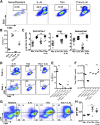Alternatively activated macrophages derived from monocytes and tissue macrophages are phenotypically and functionally distinct
- PMID: 24695852
- PMCID: PMC4023427
- DOI: 10.1182/blood-2013-08-520619
Alternatively activated macrophages derived from monocytes and tissue macrophages are phenotypically and functionally distinct
Abstract
Macrophages adopt an alternatively activated phenotype (AAMs) when activated by the interleukin-4receptor(R)α. AAMs can be derived either from proliferation of tissue resident macrophages or recruited inflammatory monocytes, but it is not known whether these different sources generate AAMs that are phenotypically and functionally distinct. By transcriptional profiling analysis, we show here that, although both monocyte and tissue-derived AAMs expressed high levels of Arg1, Chi3l3, and Retnla, only monocyte-derived AAMs up-regulated Raldh2 and PD-L2. Monocyte-derived AAMs were also CX3CR1-green fluorescent protein (GFP)(high) and expressed CD206, whereas tissue-derived AAMs were CX3CR1-GFP and CD206 negative. Monocyte-derived AAMs had high levels of aldehyde dehydrogenase activity and promoted the differentiation of FoxP3(+) cells from naïve CD4(+) cells via production of retinoic acid. In contrast, tissue-derived AAMs expressed high levels of uncoupling protein 1. Hence monocyte-derived AAM have properties associated with immune regulation, and the different physiological properties associated with AAM function may depend on the distinct lineage of these cells.
© 2014 by The American Society of Hematology.
Figures







References
Publication types
MeSH terms
Substances
Grants and funding
- R01 AI093811/AI/NIAID NIH HHS/United States
- T32 CA009161/CA/NCI NIH HHS/United States
- F32 AI102502/AI/NIAID NIH HHS/United States
- 095831/Wellcome Trust/United Kingdom
- AI094166/AI/NIAID NIH HHS/United States
- P30 CA016087/CA/NCI NIH HHS/United States
- MR/K01207X/1/MRC_/Medical Research Council/United Kingdom
- R21 AI094166/AI/NIAID NIH HHS/United States
- T32 AI007180/AI/NIAID NIH HHS/United States
- P30CA16087-31/CA/NCI NIH HHS/United States
- AI093811/AI/NIAID NIH HHS/United States
- F32AI102502/AI/NIAID NIH HHS/United States
LinkOut - more resources
Full Text Sources
Other Literature Sources
Molecular Biology Databases
Research Materials
Miscellaneous

